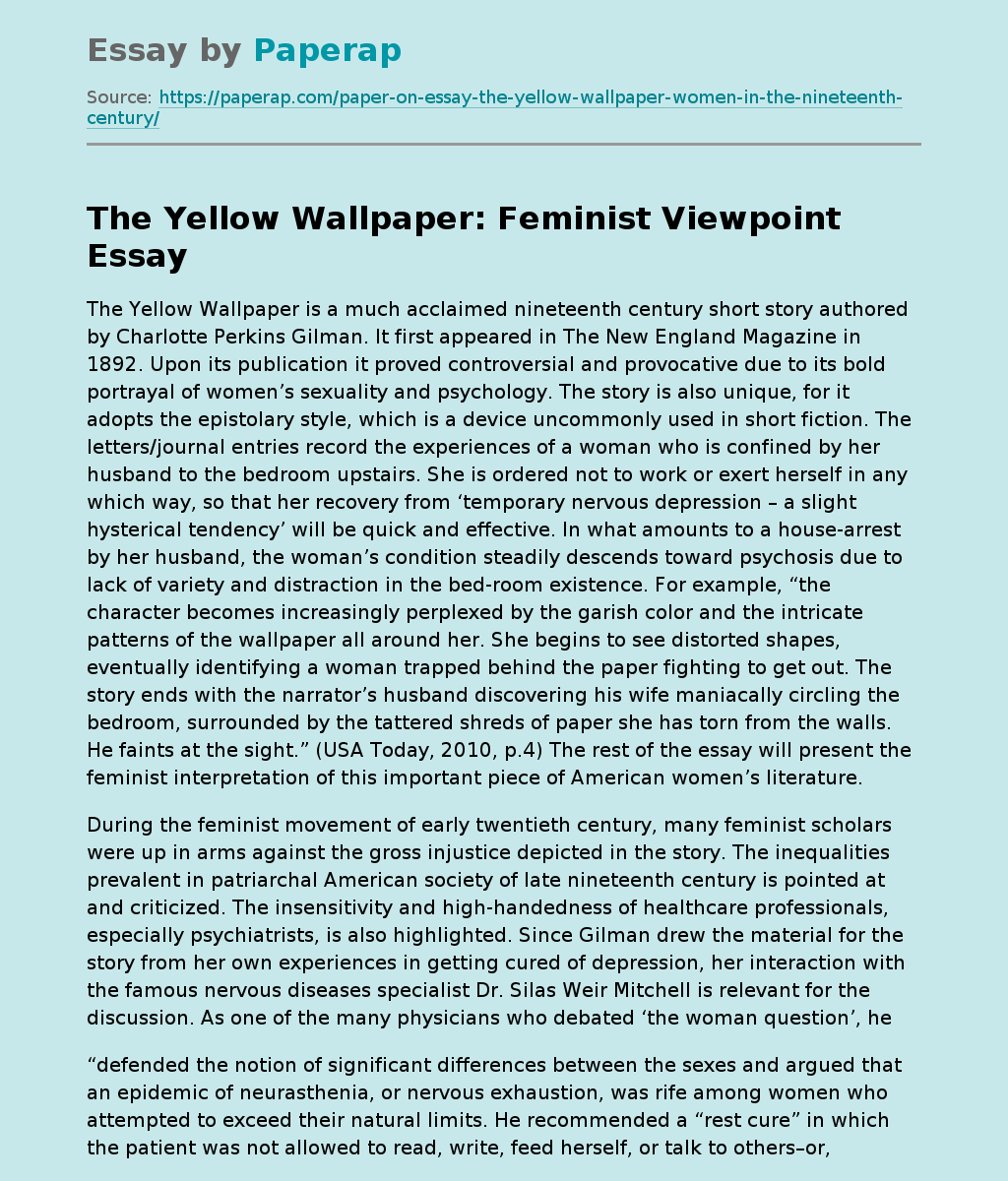The Yellow Wallpaper: Feminist Viewpoint
The Yellow Wallpaper is a much acclaimed nineteenth century short story authored by Charlotte Perkins Gilman. It first appeared in The New England Magazine in 1892. Upon its publication it proved controversial and provocative due to its bold portrayal of women’s sexuality and psychology. The story is also unique, for it adopts the epistolary style, which is a device uncommonly used in short fiction. The letters/journal entries record the experiences of a woman who is confined by her husband to the bedroom upstairs.
She is ordered not to work or exert herself in any which way, so that her recovery from ‘temporary nervous depression – a slight hysterical tendency’ will be quick and effective. In what amounts to a house-arrest by her husband, the woman’s condition steadily descends toward psychosis due to lack of variety and distraction in the bed-room existence. For example, “the character becomes increasingly perplexed by the garish color and the intricate patterns of the wallpaper all around her.
She begins to see distorted shapes, eventually identifying a woman trapped behind the paper fighting to get out. The story ends with the narrator’s husband discovering his wife maniacally circling the bedroom, surrounded by the tattered shreds of paper she has torn from the walls. He faints at the sight.” (USA Today, 2010, p.4) The rest of the essay will present the feminist interpretation of this important piece of American women’s literature.
During the feminist movement of early twentieth century, many feminist scholars were up in arms against the gross injustice depicted in the story.
The inequalities prevalent in patriarchal American society of late nineteenth century is pointed at and criticized. The insensitivity and high-handedness of healthcare professionals, especially psychiatrists, is also highlighted. Since Gilman drew the material for the story from her own experiences in getting cured of depression, her interaction with the famous nervous diseases specialist Dr. Silas Weir Mitchell is relevant for the discussion. As one of the many physicians who debated ‘the woman question’, he
“defended the notion of significant differences between the sexes and argued that an epidemic of neurasthenia, or nervous exhaustion, was rife among women who attempted to exceed their natural limits. He recommended a “rest cure” in which the patient was not allowed to read, write, feed herself, or talk to others–or, as Charlotte described it: “Live as domestic a life as possible … and never touch pen, brush, or pencil as long as you live.”” (USA Today, 2010, p.4)
The feminist grievance with respect to the prognosis of the condition lies in the fact that the depressed woman saw recuperation in totally different terms. For example, instead of spending time within the bounds of four walls, she felt an active social life would lift her out of the mental morose. This Charlotte Gilman masterpiece challenges traditional notions about gender that excluded them from mainstream political and intellectual life. It also questions how medical and scientific experts drew on notions of female weakness to justify inequality between the sexes. In Gilman’s own life, she was discouraged from pursuing a career to preserve her health. Hence the authorial voice is both autobiographical as well as generally representative of women of the era. (Delashmit & Long, 1991, p.32)
Gilman lived at a time when society was getting torn by two contradictory ideologies – True Womanhood and Women’s Rights. Through her works (including The Yellow Wallpaper) she firmly sied with the cause of women’s rights. She
“stood for the potentialities of American womanhood and struggled to free herself from true to free woman. As a woman and as an author, she perceptively analyzed the most basic conditions under which -women live out their lives and developed her seminal ideas: the crucial necessity for women to have careers outside the home; the ironclad oppression of patriarchal culture; the stultifying effects of the nineteenth century doctrine of the “woman’s sphere”; the impossible “double-bind” experience of the woman artist, and the depression and emotional breakdown which often result. Most obviously, Gilman replaces the “pure woman,” the Victorian angel in the house, with the New Woman who rejects “the biological yoke of femininity” and claims the rights, privileges, and responsibilities of a human being.” (Quawas, 2006, p.35)
The most radical perspective of The Yellow Wallpaper lies in the interpretation of the narrator’s deteriorating mental condition as a method of preserving sanity. In other words, her newfound health and well being springs forth from a rejection of and escape from an insane society. In this respect, Gilman’s main contribution to feminism lies in “her de-authorizing and de-privileging of the ideologically-saturated discourse of insanity. In her discussion of insanity, she confronts and critiques, either explicitly or implicitly, the patriarchal version of insanity and dis-empowers its authority. She condemns social systems, both political and private, which contribute to women’s psychological fragmentation, alienation, and madness.” (Quawas, 2006, p.35)
In conclusion, The Yellow Wallpaper is a key text in modern feminist discourse, although the social context in which it was written no longer fully exists. Reading the story can develop the reader’s understanding of the ‘woman question’ in the nineteenth century and advance or extend their historical sense. The changes advocated by Gilman through her work go beyond mere adjustment of power relation. She envisions sweeping change, whereby society’s very conception of what it means to be a man or a woman would undergo alteration. To the extent that this transformation is a progressive one, The Yellow Wallpaper will remain a masterpiece of feminist literature.
Works Cited:
“Bed Rest Wouldn’t Do for Pioneering Feminist.” USA Today (Society for the Advancement of Education) Feb. 2010: 4+.
Delashmit, Margaret, and Charles Long. “Gilman’s the Yellow Wallpaper.” Explicator 50.1 (1991): 32-33.
Quawas, Rula. “A New Woman’s Journey into Insanity: Descent and Return in the Yellow Wallpaper.” AUMLA : Journal of the Australasian Universities Modern Language Association (2006): 35+.
The Yellow Wallpaper: Feminist Viewpoint. (2018, Feb 23). Retrieved from https://paperap.com/paper-on-essay-the-yellow-wallpaper-women-in-the-nineteenth-century/

